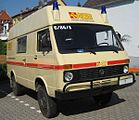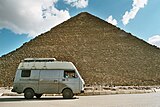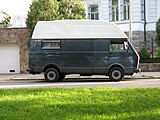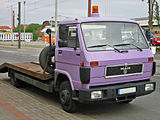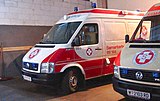VW LT
| Volkswagen Transporter LT | |
|---|---|
| Manufacturer: | Volkswagen commercial vehicles |
| Production period: | 1975-2006 |
| Previous model: | EA489 |
| Successor: | VW Crafter |
The VW LT is a van from Volkswagen AG (until 1985: Volkswagenwerk AG) that was produced in two generations from 1975 to 2006. The second generation from 1996 is almost identical to the Mercedes-Benz Sprinter . The successor to the LT series from 2006 is called Crafter and is again a joint production with Mercedes-Benz.
The type designation LT , which is the abbreviation for L asten- T ransporter, is supplemented by a two-digit number to indicate the permissible total weight . LT 28 stands for a permissible total weight of 2.8 t and Transporter LT 35 for a permissible total weight of 3.5 t.
The LT series covers the range from 2.8 t to 5.6 t.
LT - generation 1
| Generation 1 | |
|---|---|

LT combi / bus |
|
| Production period: | 1975-1996 |
| Designs: |
Panel van flatbed minibus |
| Engines: |
Otto engines : 2.0–2.4 liters (55–70 kW) Diesel engines : 2.4–2.7 liters (48–80 kW) |
| Length: | 4795-6560 mm |
| Width: | 2040-2370 mm |
| Height: | 2085-2925 mm |
| Wheelbase: | 2500-3650 mm |
| Perm. Total weight: | 2.8 t - 5.6 t |
General
In the early 1970s, Volkswagen tried to cooperate with Daimler-Benz AG to build a joint commercial vehicle, but this did not materialize. The first generation LT was presented in 1975 and caused a sensation with its excellent ratio of usable area to traffic area as well as the very good driving behavior. Thanks to the front-link design, the driver sits above the front axle, the engine is positioned lengthways between the driver and front passenger.
Engines
When introducing two water-cooled four-cylinder engines were available, a carburetor fed gasoline engine with 2.0 liter displacement and 55 kW (75 hp), which from the Audi 100 was descended and also in uprated embodiment as injection engine with 92 kW (125 hp) in the Porsche 924 using found. There was also a 2.7-liter diesel engine from the British manufacturer Perkins Engines with 48 kW (65 hp) on offer , which, however, could not convince in terms of performance and smoothness and consequently made it necessary to develop it in-house. As a result, the first in-line six-cylinder diesel engine with a displacement of 2.4 liters and an output of 55 kW (75 hp) was used as early as 1979. The Swedish vehicle manufacturer Volvo also became aware of this engine and used it, with an increased output of 63 kW (85 hp), in the Volvo 240 D6 , the first passenger car with a six-cylinder diesel engine. Other model series followed later. Volkswagen was able to respond to the desire for more engine power from 1983 when two turbodiesel versions of the 2.4-liter six-cylinder were offered. They developed 66 kW (90 PS) or 75 kW (102 PS). In the six-cylinder engine, the camshaft and coolant pump are driven by toothed belts. The diesel also has a small toothed belt on the back of the cylinder head to drive the distributor injection pump. In this context, the engine was moved back about 10 cm and inclined more strongly so that it was possible to mount a double bench seat on the passenger side. The diesel versions have now been equipped with a cold start accelerator train. When this is activated, the start of delivery of the injection pump is adjusted to "early", making starting easier and reducing the tendency to smoke blue.
In 1983, the 2.0-liter four-cylinder in-line gasoline engine (standing, high engine cover made of sheet metal) was discontinued and a six-cylinder in-line gasoline engine (inclined to the right, flat plastic engine cover) with a displacement of 2.4 liters and a carburetor introduced, the output was 66 kW (90 hp). In the course of introducing catalyst (catalyst according to the US standard), a Digifant - intake manifold adapted to the engine with the 2.4-liter gasoline engine now kW (94 hp) 69th Both six-cylinder engines are two-cylinder longer versions of the Volkswagen 1.6-liter four-cylinder engine (an offshoot of the EA 827), but like the later versions of the EA 827, the water pump drive was "anticipated" by a toothed belt. In 1993, with the facelift, revised diesel engines were used again, including intercooling and 70 kW (95 hp).
Technical specifications
| engine | Code letter | Design | Displacement | Mixture preparation | Power kW / (PS) | construction time |
| Otto engines : | ||||||
| 2.0 | CL | R4 | 1984 cc | Carburetor | 52 kW (71 hp) | 05 / 76-11 / 82 |
| 2.0 | CH | R4 | 1984 cc | Carburetor | 55 kW (75 PS) | 04 / 75-11 / 82 |
| 2.4 | DL | R6 | 2383 cc | Carburetor | 66 kW (90 PS) | 08 / 82-07 / 92 |
| 2.4 | 1E | R6 | 2383 cc | Manifold injection with catalytic converter | 69 kW (94 PS) | 08 / 88-12 / 95 |
| Diesel engines : | ||||||
| 2.7 Perkins diesel | CG | R4 | 2702 cc | Pre-chamber injection | 48 kW (65 hp) | 01 / 76-11 / 82 |
| 2.4 D | CP | R6 | 2383 cc | Swirl chamber injection | 55 kW (75 PS) | 08 / 78-11 / 82 |
| 2.4 D | DW | R6 | 2383 cc | Swirl chamber injection | 55 kW (75 PS) | 12 / 82-07 / 92 |
| 2.4 D | 1S | R6 | 2383 cc | Swirl chamber injection | 51 kW (69 hp) | 08 / 88-07 / 92 |
| 2.4 D | ACT | R6 | 2383 cc | Swirl chamber injection | 51 kW (69 hp) | 08 / 92-12 / 95 |
| 2.4 turbo diesel | 1G | R6 | 2383 cc | Vortex chamber injection with turbocharging | 68 kW (92 hp) | 08 / 88-07 / 89 |
| 2.4 turbo diesel | DV | R6 | 2383 cc | Vortex chamber injection with turbocharging | 75 kW (102 PS) | 12 / 82-07 / 92 |
| 2.4 Turbo diesel with charge air cooling | ACL | R6 | 2383 cc | Vortex chamber injection with turbocharging and charge air cooling | 70 kW (95 PS) | 08 / 91-12 / 95 |
Versions
When the LT was launched, two wheelbases (2500 mm and 2950 mm) and two roof heights were available, as a mobile home there was the Transporter LT as a special model, e.g. B. Westfalia Sven Hedin / VW Florida , which offered two additional sleeping places with the special high roof. The second high-volume motorhome on LT was the alcove extension from Karmann-Mobil (last marketed as Distance Wide ). An extended version of the platform with 3650 mm was added later. The LT was available both as a station wagon with up to 14 seats, as a panel van , as a mobile home and as a flatbed or chassis with a simple driver's cab and as a double cab . The LT cab was also used for MAN's G series . In 1992 another facelift took place with a new radiator grille, modified bumpers and plastic covers around the rectangular headlights . The LT was also used in the rescue service or by fire brigades, for this purpose it was removed and modified by the relevant companies. The LT 28, 31 and 35 models were often used by fire brigades as portable fire pumps (TSF) and some of them are still in use today in small village fire brigades.
landing gear
When the LT was launched, it had an independent front suspension with double wishbones and coil springs. The large width of the vehicle resulted in excellent driving behavior for a light truck. This front axle was retained for the LT 28, LT 31 and LT 35 models until the end. In order to meet the customer's request for a higher payload, a rigid front axle with two longitudinal leaf springs was also offered as an option for the LT 35 from 1979. At the same time, the LT 40 and LT 45 models were introduced, in which this front axle was used as standard, as was the case with the later introduced LT 50 and LT 55. Disc brakes were used on the front axle and drum brakes on the rear axle. The brakes were hydraulically operated with two circuits and fitted with a brake force regulator on the rear axle. The recirculating ball steering system known from Type 2 was used as the steering gear, initially without a servo. This was introduced with the first major facelift in 1983. The rear axle is a rigid axle with two longitudinal leaf springs and single-tube shock absorbers. The load-dependent brake force regulator is also located there, which regulates the brake pressure to the rear axle depending on the load condition. The final drive could be delivered in different gear ratios. The LT 28, LT 31 and LT 35 series had single tires on the rear axle. From version LT 40 and for the LT 35 as additional equipment, twin tires were provided. The standard versions were equipped with 14-inch wheels.
All-wheel drive (LT 4 × 4)
The LT 4 × 4 is a series of its own and has good driving characteristics in the field. The standard gearbox was followed by a transfer case that could be reduced, which transferred the power of the engine in a ratio of 1: 1 to the rear and the selectable front axle. When driving with the reduction of the transfer case and optionally locked differentials, the LT, equipped with motors from 75 HP to 109 HP, managed inclines of 45 °. The LT 4 × 4 was available as LT 40 and LT 45 in all versions that were also available for the 4 × 2, but only with the middle wheelbase (2950 mm). The forerunner for the VW LT 4 × 4 was the Sülzer LT 4 × 4 developed by Sülzer Fahrzeugbau in Augsburg. In addition, an LT-based vehicle called Noriker was built at Steyr Daimler Puch in Austria , but it did not go into series production.
Facelifts
In 1985 the round headlights were replaced by rectangular ones and other small cosmetic changes were made. In the spring of 1993 there was another moderate change. Since then, the front elements have been framed by gray plastic panels.
MAN-VW G90 truck
Based on the first generation of the LT, the G 90 was developed in cooperation with MAN . The model appeared in 1979 with gross vehicle weights between 6 and 9 t, and from 1981 also 10 t, with a choice of two diesel engines with 66 kW (90 hp) and 100 kW (136 hp). The engines, chassis and front axles were supplied by MAN, while the cab, gearbox and rear axles derived from the first generation of the LT came from VW. The front of the vehicles was adorned with the logos of both companies. The only major revision took place in 1987, the engine output increased to 74 kW (100 PS) and 110 kW (150 PS), the previously round headlights next to the radiator grille were replaced by square ones in the bumper. The G 90 was also built by Volkswagen Caminhões e Ônibus in Brazil under other names for the South American market. In North America , Kenworth marketed the model as the Kenworth K300 . In 1993, the production of VW and MAN models in Europe ended without a successor model. Production in South America ended in 1994, and the VW L80 followed in 1995 , which has been modernized to this day as VW Delivery and the VW Worker derived from it.
LT - generation 2
| Generation 2 | |
|---|---|
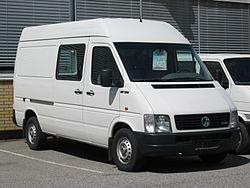
LT 35 box van 2.5 TDI |
|
| Production period: | 1996-2006 |
| Designs: |
Panel van flatbed minibus |
| Engines: |
Otto engine : 2.3 liters (105 kW) Diesel engines : 2.5–2.8 liters (55–116 kW) |
| Length: | 4835-6803 mm |
| Width: | 1922-2157 mm |
| Height: | 2145-2610 mm |
| Wheelbase: | 3000-4025 mm |
| Payload: | 2.8 t - 5.6 t |
The second generation of the LT appeared in 1996 and was almost identical to the Mercedes-Benz Sprinter . It was completely redeveloped jointly by Daimler-Benz and Volkswagen (Euro chassis). The LT were completely manufactured by Volkswagen Commercial Vehicles in the Hanover plant , the Sprinter by Daimler-Benz in Düsseldorf . In contrast to the predecessor, force-fit glued windshields and rear windows as well as water-based paints were used for the body. A mechanical differential lock , air conditioning , additional air heating and driver and passenger airbags could be ordered as additional equipment .
2nd generation VW LT TDI ambulance
Engines
The standard was a five-cylinder diesel engine with direct injection, 2.5 liter displacement and an electronically controlled distributor injection pump without charging, which was designated as SDI. It developed 55 kW (75 PS). Further variants were the turbodiesel engines with direct injection TDI and an output range from 61 kW (83 PS) to 80 kW (109 PS). There was also a four-cylinder turbodiesel engine with a displacement of 2.8 liters, which was supplied to VW by Motores MWM Brasil and developed 92 kW (125 PS) (later 131 PS). This was equipped with a modern common rail injection from 2002 and thereby gained in smoothness and engine power (116 kW and 158 PS). A fan with a viscous coupling was used to support the engine cooling .
Since its introduction, there has also been a 2.3-liter gasoline engine from Mercedes-Benz (type M 111 E 23 ) with 105 kW (143 hp), which, however, was practically not for sale and was therefore later discontinued. This variant was the only one that could be combined with an automatic transmission. The engines were installed lengthways and delivered the power to a synchronized five-speed gearbox via a single-disc dry clutch .
Versions
The LT2 was available with three different wheelbases (3000 mm, 3550 mm and 4025 mm) and two different roof heights. The longest wheelbase can be recognized by the yellow side marker lights. Body variants were box, station wagon, flatbed or chassis with driver's cab or double cab. Volkswagen also offered a mobile home based on the LT2, in cooperation with Karmann-Mobil (Rheine or later Sprendlingen), under the name Missouri .
landing gear
To reduce the turning circle, the chassis had a transverse leaf spring and two single-tube shock absorbers at the front, and two leaf springs installed lengthways at the rear. The engine and gearbox transferred the power to the rear axle, which on the LT 46 had twin tires. This was also available as an option for the LT 35. The rack and pinion steering was equipped with power assistance in all variants. The brake system had disc brakes on the front and rear axles, which were internally ventilated at the front and, on the LT 46, also at the rear. The parking brake acted on the rear wheels and consisted of a small drum brake integrated into the rear brake disc. There was a large number of different axle ratios depending on the task at hand. Unlike the predecessor, all-wheel drive was no longer offered.
Technical specifications
| 2.3 | 2.5 SDI | 2.5 TDI | 2.8 TDI | |||||||
|---|---|---|---|---|---|---|---|---|---|---|
| Construction period | 05 / 1996-11 / 2001 | 05 / 1996-04 / 2001 | 04/2001–07/2006 | 05 / 1999-05 / 2003 | 04/2001–07/2006 | 05 / 1996-05 / 1999 | 05 / 1999-07 / 2006 | 07/1997–12/1998 | 01/1999–01/2002 | 02 / 2002-07 / 2006 |
| Engine characteristics | ||||||||||
| Engine type | R4 petrol engine | R5 diesel engine | R4 diesel engine | |||||||
| Number of valves per cylinder | 4th | 2 | 3 | |||||||
| Valve control | DOHC , chain | OHC, timing belt | OHC, gears | |||||||
| Mixture preparation | Manifold injection | Direct injection | Common rail injection | |||||||
| Engine charging | - | Turbocharger , intercooler | ||||||||
| cooling | Water cooling | |||||||||
| Engine manufacturer | Mercedes Benz | Volkswagen | Motores MWM Brasil | |||||||
| Engine code | AGL | AGX | BBE | APA | BBF | AHD | ANJ, AVR | AGK | ATA | AUH, BCQ |
| Bore × stroke | 90.9 x 88.4 mm | 81.0 x 95.5 mm | 93.0 x 103.0 mm | |||||||
| Displacement | 2295 cc | 2459 cc | 2798 cc | |||||||
| Compression ratio | 8.8: 1 | 19.5: 1 | 19.1: 1 | |||||||
| Max. power | 105 kW (143 hp) at 5000 rpm |
55 kW (75 PS) at 3800 rpm |
61 kW (83 PS) at 3500 rpm |
66 kW (90 PS) at 3500 rpm |
70 kW (95 PS) at 3500 rpm |
75 kW (102 PS) at 3500 rpm |
80 kW (109 PS) at 3500 rpm |
92 kW (125 PS) at 3500 rpm |
96 kW (130 PS) at 3500 rpm |
116 kW (158 hp) at 3500 rpm |
| Max. Torque | 210 Nm at 4000 rpm |
160 Nm at 2000-2400 rpm |
200 Nm at 1500-2500 rpm |
220 Nm at 1800-2500 rpm |
240 Nm at 2200-2500 rpm |
250 Nm at 1900-2300 rpm |
280 Nm at 1900-2500 rpm |
280 Nm at 2200 rpm |
300 Nm at 2000-2500 rpm |
331 Nm at 2000-2500 rpm |
| Power transmission | ||||||||||
| drive | Rear wheel drive | |||||||||
| Gearbox, as standard | 5-speed manual transmission | |||||||||
| Gearbox, optional | 4- speed automatic transmission | - | ||||||||
| Readings | ||||||||||
| Top speed | 143–157 km / h | 100-125 km / h | 125-133 km / h | 118-137 km / h | 128-140 km / h | 110-143 km / h | 129-148 km / h | 118-153 km / h | 121–156 km / h | 134-160 km / h |
LT - Generation 3 - Crafter
The third generation, from now on no longer called LT, but Crafter , is almost identical to the Mercedes-Benz Sprinter. Above all, it differs significantly from its predecessor due to the massive radiator grille. Five-cylinder diesel engines with common rail injection systems, turbochargers and soot particle filters serve as the drive . The Crafter was in the Mercedes-Benz -Werken Dusseldorf and Ludwigsfelde built together with the Sprinter.
literature
- VW LT operating instructions . Volkswagen AG, April 1998 (Danish).
- VW LT logbook, booklet 3.3 "Technical data" . Volkswagen AG, August 2000 (Danish).
- VW LT logbook, booklet 3.3 "Technical data" . Volkswagen AG, May 2001.
- VW LT logbook, booklet 3.5 "Addendum" . Volkswagen AG, May 2002.
Web links
Individual evidence
- ↑ List of discontinued engines from MWM Brasil
- ↑ a b List of VAG motors on vag-codes.info . Accessed April 27, 2014
